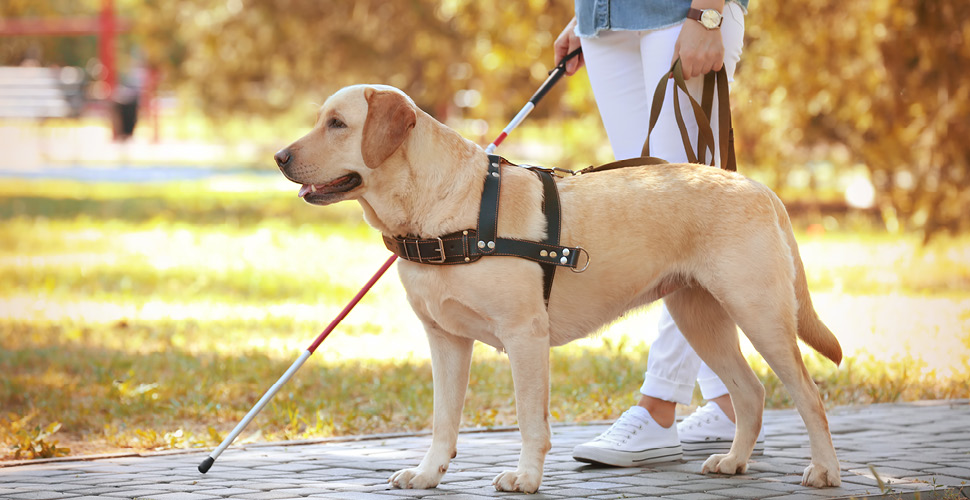There are approximately 500,000 service dogs in America. More and more people are incorporating service dogs into their lives. Some service dogs exist to provide emotional support, while others offer life-saving help by reminding individuals to take their medicine, alert them when their blood sugar drops too low or protect them while seizing.
Yet, despite their life-saving abilities, service dogs and their owners still bear the burden of common misconceptions. We’re here to debunk the top misconceptions about service dogs and their owners.
Emotional Support Dogs are the Same as Service Dogs
It’s a common misconception and point of confusion for many when it comes to the differences between emotional support pets and service dogs. The two are NOT the same, though they both fulfill a very important purpose.
Emotional Support Dog
A defined and untrained pet who emotionally supports his or her handler. With a doctor’s note, support dogs are allowed to fly in the cabin of an aircraft free of charge and live in no-pets-allowed housing.
Service Dog
A service dog is defined as medical equipment. Service dogs are specifically trained to do work or tasks related to mitigating a person’s disability.
While both are important to their owners, each one serves a different purpose and objective.
1) Service Dogs are Certified or Required After Completing Training
In the U.S. there is no official or legitimate federal or state identification card or certificate that “proves” a dog is a trained service dog. As a result, many scam websites have popped up selling “required” or “mandatory” products. This is one of the main reasons these misconceptions exist because of these scam sites.
2) Service Dogs are Only for the Deaf or Blind
While this may have been the initial purpose of service dogs, the service dogs of today exist to assist in a wide variety of illnesses and disabilities. Today’s service dogs are used by those who may have diabetes or experience seizures, among other countless illnesses and disabilities. A service dog can be trained to assist and protect its owner for a wide variety of conditions.
3) The Training Period is Short
Service dogs are never done learning. These dogs must be able to adapt to their handlers’ needs as they change over time. And, just like anyone who learns a skill, once in a while they need a little touch-up on their skills. Traditional training time for a service dog takes about 2 years with training touch-ups throughout their career.
4) Service Dogs Work All the Time and Never Get to Have “Fun”
Being a service dog is definitely not all work and no play. In fact, it’s one of the best jobs a dog can have! For starters, they get to be with their owner 24/7! They have a job and a purpose which keeps them from getting bored.
5) Bully Breeds Can’t Be Service Dogs
Any breed, shape or size of dog has the potential to be a service dog. As long as the dog is healthy, exhibits a stable temperament, and can be trained to do the necessary work, they can be service dog. Typically, you will see specific breeds as service dogs because of their temperament but any dog can be one. In fact, the “odd” breeds can make for some of the best service dogs.
6) People With Service Dogs are Lucky Their Dog Can Go Everywhere With Them
While it would be nice if we could all take our dogs everywhere with us. But the reality is that those who have a service dog aren’t exactly “lucky.” Their service dog is there because they have a condition that, in some cases, may impact their capacity to perform at least one major life task. The dog’s purpose is to help their own life more independently. Of course, it doesn’t hurt that the dogs are cute and sweet.
7) It’s Okay to Pet a Service Dog If The Handler Isn’t Looking
As harmless as simple “drive-by pat” may seem, it’s actually incredibly distracting and can be harmful for the dog and its handler. Most states have laws prohibiting interference with or intentionally injuring service dogs. Remember, these dogs are “on the job” and should be admired from a respectful distance with zero touchings.
8) People With Service Dogs are Always Open to Chatting
Are you always open to chatting while in public? Probably not. Just because someone has a service dog doesn’t mean they’re an open book. Just like you, people with service dogs want to maintain their own sense of privacy while in public. Additionally, they don’t probably don’t want to talk about why or how they got their dog. Respect their space and if you have questions, Google them.
Keep Your Service Dog Healthy
Whether you have a service dog or know someone who does, keeping them healthy and hydrated is a #1 priority. When they’re at the top of their A-game, then they can help protect and serve their handlers. Learn more about how Kinn Kleanbowls can help your service dog stay healthy and purchase your very own starter kit!


